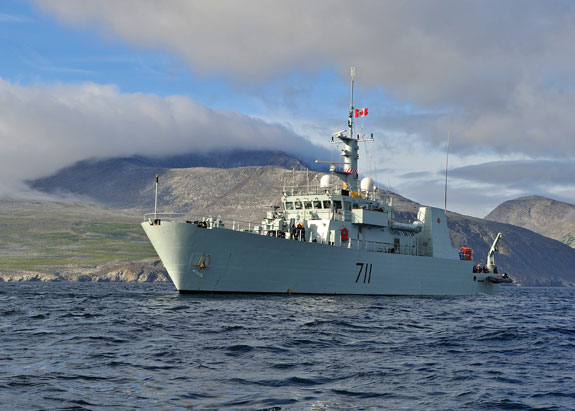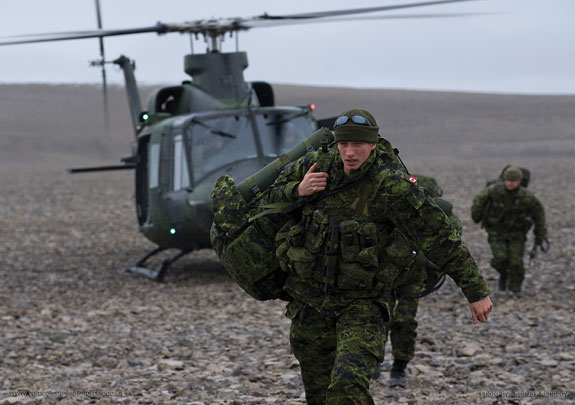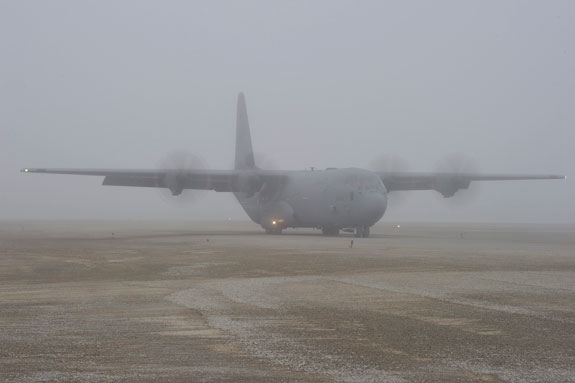 This information has been archived for reference or research purposes.
This information has been archived for reference or research purposes.
Archived Content
Information identified as archived on the Web is for reference, research or recordkeeping purposes. It has not been altered or updated after the date of archiving. Web pages that are archived on the Web are not subject to the Government of Canada Web Standards. As per the Communications Policy of the Government of Canada, you can request alternate formats on the "Contact Us" page.
Valour (Vol. 11, No. 4)
Commentary

DND photo HS2011-H003-009 by Corporal Rick Ayer
Defence and the 2011 Election
By Martin Shadwick
For more information on accessing this file, please visit our help page.
The federal election campaign of 2011 was far from stimulating or exciting, but few would deny the watershed nature of the final outcome. Stephen Harper’s Conservatives, after multiple attempts, finally secured their long-sought majority in the House of Commons. The once omnipotent Liberals plummeted from official Opposition status to third place—perhaps slightly mollified by the electoral survival of sufficient MPs to provide the critical mass for a lengthy and difficult period of rebuilding—while the New Democrats, much to their own shock, vaulted from fourth place to form the new official Opposition. The promotion will, of course, provide a much more visible and prestigious platform for voicing the NDP perspective on Canadian foreign and defence policy, but it will also generate more intense scrutiny of the party’s positions. The Bloc Quebecois, a fixture on Parliament Hill for two decades, was essentially decimated—although federalists would be prudent not to read too much into the Bloc’s fate at the hands of the NDP—while the Green Party of Canada secured its first elected Member of Parliament, fittingly, leader Elizabeth May. Interesting times, indeed.
Defence policy made a cameo appearance in the 2011 campaign (primarily because of the Harper government’s proposed acquisition of 65 F-35s to replace the veteran CF-18s), but the continued absence of foreign and defence policy, both important and not inexpensive public policy areas, from Canadian federal election campaigns, remains deeply troubling. If one examines the role of defence in the four most recent elections, the tally is a cameo appearance in 2011, near-invisibility in the election of 2008 (thereby falling short of even cameo status), a modest (and rather bizarre) appearance in 2006, and a somewhat more edifying stature in 2004. In the 2006 election, defence received some attention as a result of the Conservative pledge to create mixed regular/reserve “territorial defence battalions” in or near major urban areas. Condemned, rightly, by historian Jack Granatstein on the grounds that it would “fritter away scarce trained regulars in penny packets,” the idea is best remembered for prompting the Liberals to produce—but ultimately not to broadcast—a television commercial warning of “troops in the streets.” Defence achieved a somewhat loftier status in the 2004 election, when the Liberals pilloried the Conservatives for their perceived “massive military build-up,” but then weakened their own case by misrepresenting a Conservative pledge to acquire “hybrid carriers”—admittedly a most unfortunate choice of words—for helicopter support and sealift.
In the 2011 campaign, the NDP platform envisaged three “main priorities” for the Canadian Forces: (1) “defending Canada”; (2) “providing support for peacemaking, peace-building and peacekeeping around the world”; and (3) “assisting people facing natural catastrophes, including floods, earthquakes, forest fires and other emergencies, both at home and abroad.” The New Democrats pledged to “ensure the Canadian Forces are properly staffed, equipped and trained to effectively address the full range of possible military operations” arising from the three priorities, “maintain the current planned levels of defence spending commitments,” “equip the Canadian military to resume leadership in United Nations peacekeeping operations,” and “improve search and rescue capability to international standards within the current budgetary framework.” A new white paper on defence charged with “redefining our military’s role, its priorities and needs” would be completed within twelve months of taking office. During that time, “all major defence projects”, including the F-35, would be “reviewed.” Also envisaged, “within the existing budget”, was an “annual fund for government shipbuilding” to “provide stability to the industry and include construction of new ships for the Navy and the Coast Guard.” In an Esquimalt speech, NDP leader Jack Layton stated that “for five years Stephen Harper has failed to procure the ships we need to patrol the world’s longest shoreline. Canada’s supply ships have reached the end of their operational lives. Instead of focusing on [F-35s], I’ll get the job done when it comes to building Joint Support Ships for our naval forces.” The latter are not irrelevant to coastal patrol, but it is curious that the NDP leader would seize upon the importance of Joint Support Ships, rather than coastal patrol vessels.
Michael Ignatieff’s Liberals envisaged “a return to peace operations,” and a revitalized commitment to the Responsibility to Protect (R2P). Their platform noted that “traditional peacekeeping has changed significantly since Canada vacated the field. Increasingly, deployments are undertaken to more complex and often dangerous situations, better described as peace-making missions. These increasingly involve combat. Based on the hard-earned experience in Afghanistan, a Liberal government will develop a new leadership role for Canada in today’s peace operations. It will include training, commanding and deploying personnel where it’s clear that a mission is consistent with Canada’s interests, values, and capabilities.” Given that a Liberal government would “have a very different vision of Canada’s role in the world,” the “entire procurement programme in the Department of National Defence will have to be reviewed in the context of that changing role.” The Liberals pledged to cancel “the Harper [F-35] deal,” adding that “when Canada purchases new fighter planes, we will have a transparent, competitive process to procure equipment that best meets our needs, achieves best value for money, secures maximum industrial benefits, and fits a realistic budget.” The financial savings from the end of the combat mission in Afghanistan would be reallocated “in a balanced manner across the full spectrum of defence, development and diplomacy.”
The incumbent Conservatives fashioned much of their defence platform around reaffirmations of support for a host of previously announced initiatives, ranging from acquisition of the F-35 and the Arctic/Offshore Patrol Ship (AOPS), to the creation of an expeditionary air wing at CFB Bagotville, and the implementation of a National Shipbuilding Procurement Strategy (NSPS). In the most robustly partisan statement concerning defence policy during the election, the Conservative platform declared that “the previous Liberal government refused to provide our men and women in uniform the tools they need to do their job, sending them into harm’s way without the necessary equipment. Since then, the Ignatieff-led Coalition has opposed every attempt to reverse the effects of what our military calls the ‘Decade of Darkness’. In spite of this obstruction, Stephen Harper’s Government has taken major steps forward to ensure the [Canadian Forces] have the equipment they need to defend our country.”
The very modest (dare one say stealth-like?) presence of defence in the 2011 election provides comparatively little scope for fresh analyses, but some themes are deserving of note. It is intriguing, for example, that the opposition parties were unable to get real traction with the F-35 issue, and failed to emulate Jean Chrétien’s success in bashing the Progressive Conservatives with the EH101 during the 1993 election. For the Liberals, part of the problem may have been an inability or unwillingness to replicate Chrétien’s legendary street fighter style, but it is important to remember that it was relatively easy—albeit misleading—to label the EH101 a Cold War relic when the Cold War had just ended. In the case of the missing F-35 debate, the Liberal acknowledgement that a CF-18 replacement of some description, and considerable cost, would still be required, the absence of a signed F-35 contract (thereby making the issue appear somewhat abstract), and a less cavalier post-9/11 approach to security on the part of Canadians may have been contributing factors.
Also noteworthy, as Jack Granatstein pointed out in a post-election commentary for the Canadian Defence and Foreign Affairs Institute, were the “Liberal and NDP platform positions on peacekeeping. Both were enthusiastic about serving the United Nations; neither seemed unduly interested in war-fighting, although the Liberals, whose agreement was essential for the 2008 three-year extension of combat in Afghanistan and for the three-year training commitment there, did seem to concede it as a possibility.” Arguing that “the real question…is whether Canada and the Western nations should put future military action in the hands of the United Nations and the Security Council,” Granatstein took careful note of Ignatieff’s pro-UN positions during the election, contrasted them with Ignatieff’s blunt criticisms of the UN prior to his return to Canada, and concluded that “his personal and party defeat does suggest that no leader should run against his convictions. Or, perhaps, that political expediency is not always the best course.”

DND photo IS2010-6617-011 by Corporal Jax Kennedy
For the Conservatives, majority status will facilitate the shift to a more muscular foreign policy, anchored, as Prime Minister Harper noted in a fascinating July 2011 interview with Maclean’s, by perceptions of Canada as a “courageous warrior, compassionate neighbour [and] confident partner.” He acknowledged that “we’ve received some criticism for re-investing in our military, but when you’re in a dangerous world and countries are from time to time called upon to do things to deal with those dangers, if you don’t have the capacity to act you are not taken seriously. Nobody takes your views seriously unless you can contribute to solutions, and it’s very difficult to contribute to solutions unless you can contribute across the range of capabilities, up to and including military capabilities.” The world, he added, “is becoming more complex, and the ability of our most important allies, and most importantly the United States, to single-handedly shape outcomes and protect our interests, has been diminishing, and so I’m saying we have to be prepared to contribute more, and that is what this government’s been doing.”
Canadian attitudes on security have, to some extent, shifted in the post-9/11 era, but in a nation where a stereotyped and romanticized notion of peacekeeping remains deeply rooted in the national psyche, wherein visions of a more muscular foreign policy—even one, as the Prime Minister has noted, that includes peacekeeping—will require a careful and thoughtful nurturing of public support. It therefore seems more important than ever that the Conservatives move forward with a clear, cogent, and compelling white paper or other major policy statement on foreign policy, and a freshened and considerably more detailed Canada First Defence Strategy written with an eye to Canadian defence policy in the post-Afghanistan geo-strategic environment. In addition to outlining their world view and identifying the appropriate mix of real-world capabilities—both military and non-military—the Conservatives need to deal with fiscal and other realities. The Canadian economy has fared better than many others, but the economic recovery remains fragile, the manufacturing base has suffered serious damage, and overall debt levels—federal, provincial, and individual—remain distressingly high. Competing demands upon the public purse, not least those related to health care, will continue to grow. The Harper government has injected significant national treasure into defence, but it is clear that there are limits…and no credible way to isolate defence from Ottawa’s broader ‘belt-tightening.’

DND photo IS2011-0006-57 by Sergeant Norm McLean
This, one fervently hopes, need not mean a Canadian clone of the United Kingdom’s capability-slashing 2010 Strategic Defence and Security Review (SDSR)—in reality, more a massacre than a review—but it does mean that some hard choices will be required. The mid-2011 decision to phase out the Canadian component of the NATO airborne early warning force (i.e., AWACS)—clearly the end of an era for the Canadian military presence in Central Europe—provides but one example of fiscal pruning. Further reductions could embrace any number of options, including reductions in the number of headquarters (or, at the very least, reductions in headquarters staffing levels), reductions in the number of reservists on full-time duty, quantitative and/or qualitative ‘walkbacks’ in new procurement, and, while politically dangerous, the closure of bases and other installations. Desirable acquisitions, such as a fifth C-17 Globemaster III transport, are likely to prove ‘non-starters.’
The post-election Conservatives also need to move faster with respect to the reform of a clearly broken procurement system, upon reinvigorating search and rescue and upon resuscitating the military presence in the Arctic. It is supremely ironic that long-standing Conservative plans for an expanded military presence in the Arctic were initially condemned, largely but not exclusively by left-learning academics, on the grounds that Ottawa was attempting to ‘militarize’ the north. The complaint was frankly ludicrous, given the very modest number of personnel required to operate the proposed northern training centre, northern refuelling facility, and, say, one or two Arctic/Offshore Patrol ships, but without prompt action, the Conservatives will find themselves increasingly vulnerable to the more recent political and media charge that the promised Arctic expansion has stalled at the ‘exercise photo-op’ level. There are reasons for the delay—including time-consuming environmental assessments, the brief northern construction season, and various challenges on the AOPS front—but the Conservatives would be prudent to hasten the glacier-like pace of these projects. Credibility, after all, comes in many forms.
Martin Shadwick teaches Canadian defence policy at York University. He is a former editor of Canadian Defence Quarterly.






